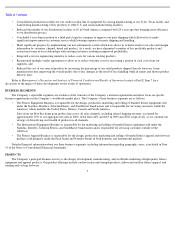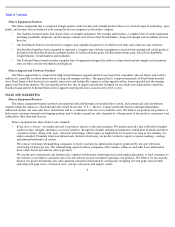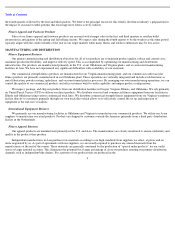Nautilus 2006 Annual Report Download - page 17
Download and view the complete annual report
Please find page 17 of the 2006 Nautilus annual report below. You can navigate through the pages in the report by either clicking on the pages listed below, or by using the keyword search tool below to find specific information within the annual report.
Table of Contents
performance of services by third parties, including those involved in shipping product to and from our distribution facilities. In the U.S., we
rely primarily on our distribution centers in Portland, Oregon, Independence, Virginia, Tulsa, Oklahoma, Bolingbrook, Illinois, and
Broomfield, Colorado, and in Europe we rely primarily on a warehouse in Kirchzarten, Germany and a third party warehouse and logistics
provider in the Netherlands.
Our distribution facilities could be interrupted by disasters such as earthquakes or fires. We maintain business interruption insurance, but
it may not adequately protect us from the adverse effect that could be caused by significant disruptions in our distribution facilities.
Failure to maintain our information systems could result in interruptions to our business
Our business is increasingly reliant on information technology. Information systems are used in all stages of our production cycle, from
design to distribution, and are used as a method of communication between employees, our subsidiaries overseas, as well as our customers. We
also rely on our information systems to allocate resources and forecast operating results. System failures or service interruptions may occur as
the result of a number of factors, including computer viruses, hacking or other unlawful activities by third parties, disasters, or failure to
properly protect, repair or maintain systems. Any interruption of critical business information systems may have a material adverse affect on
our results of operations and financial condition.
Unsuccessful implementation of our growth strategies may adversely affect revenues and decrease margins
We face many challenges in implementing our growth strategies. For example, our expansion into international markets may involve
countries where we have little sales or distribution experience and where our brand is not yet widely known. Expanding our product categories
involves, among other things, gaining experience with new products, gaining consumer acceptance and establishing and protecting intellectual
property rights. Increasing sales to department stores and improving the sales productivity of our customers will each depend on various factors
including strength of our brand name, competitive conditions, our ability to manage increased sales and future expansion, the availability of
desirable locations, and the negotiation of favorable terms with retailers. Future terms with customers may be less favorable to us than those
under which we currently operate. Large retailers increasingly seek to transfer various costs of business to their vendors such as the cost of lost
profits from product price markdowns.
To implement our business strategy, we must manage growth effectively. We will continue to change various aspects of our business, to
maintain and enhance our information systems and operations to respond to the increased market demand, and to attract, retain and manage
qualified personnel. Growth could place an increasing strain on management, financial, product design, marketing, distribution and other
resources, and we could experience operating difficulties. Growth involves many risks and uncertainties that, if not managed effectively, could
have a material adverse effect on our results of operations and financial condition.
Currency exchange rate fluctuations could result in higher costs and decreased margins
We have significant sales outside of the U.S. As a result, we conduct transactions in various currencies which increase our exposure to
fluctuations in foreign currency exchange rates relative to the U.S. dollar. Our international revenues and expenses generally are derived from
sales and operations in foreign currencies, and these revenues and expenses could be affected by currency fluctuations. Currency exchange rate
fluctuations could also disrupt the business of the independent manufacturers that produce our products by making their purchases of raw
materials more expensive and more difficult to finance. Therefore, our future financial results could be significantly affected by the value of the
U.S. dollar in relation to the foreign currencies in which we conduct business.
Our business is affected by seasonality which results in fluctuations in our operating results
We experience moderate fluctuations in aggregate sales volume during the year. Historically, revenues in the first and fourth quarters
have exceeded those in the second and third quarters. However, the mix of product sales may vary considerably from time to time as a result of
changes in seasonal and geographic demand for particular
15
























